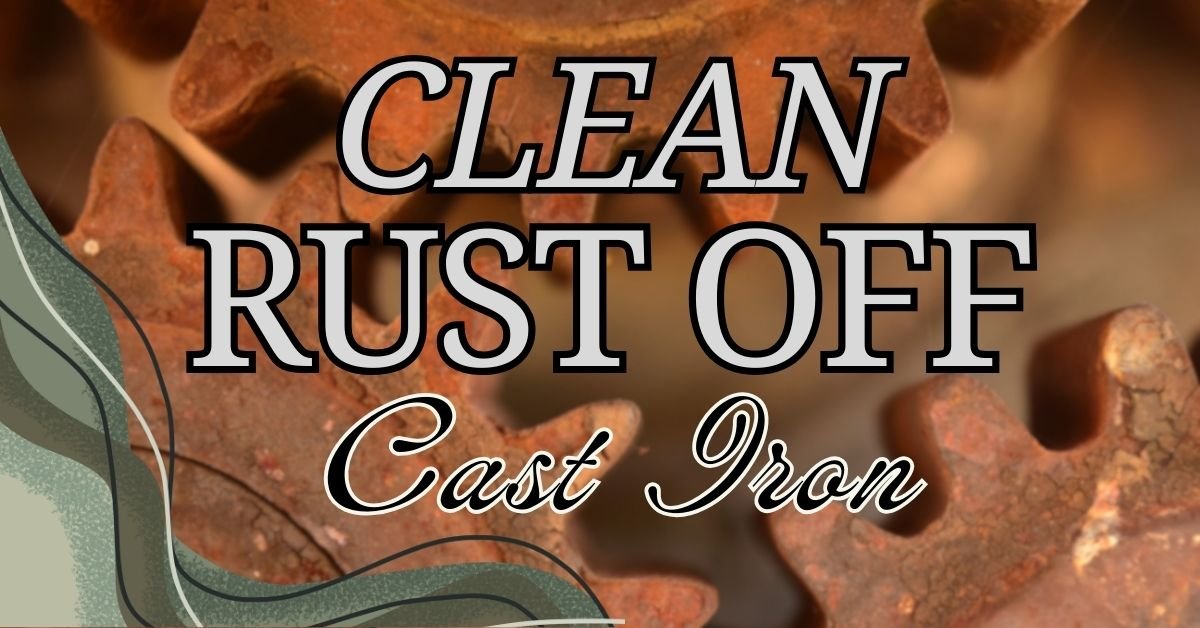Cast iron cookware is known for its durability and excellent heat retention, making it a favorite in many kitchens. However, rust can develop over time due to moisture and improper care. Understanding how to clean rust off cast iron is essential for its longevity and cooking performance. This guide will provide you with effective methods to clean rust off your cast iron cookware, ensuring it remains a reliable tool in your kitchen.
What Causes Rust on Cast Iron?
Rust forms when iron reacts with moisture and oxygen, a process known as oxidation. Cast iron is particularly susceptible due to its porous nature, which allows moisture to seep into its surface. Several factors contribute to this process, and understanding them can help you take preventive measures. One major factor is moisture exposure. If cast iron cookware is left in a damp environment, rust can develop quickly. This is especially true if the cookware is not dried thoroughly after washing.
Improper cleaning techniques can also lead to rust. For instance, soaking cast iron in water for extended periods can trap moisture, promoting rust growth. Additionally, failing to season your cast iron regularly can leave it vulnerable. Seasoning creates a protective layer that acts as a barrier against moisture. When this layer is worn away, the bare iron is exposed, increasing the risk of rust.
Using acidic ingredients, such as tomatoes, can also affect the seasoning layer. If you frequently cook acidic foods without reseasoning afterward, you may notice rust appearing sooner than expected. By understanding these factors, you can adopt better practices to maintain your cast iron cookware and prevent rust from forming in the first place.
Fastest Ways to Remove Rust from Cast Iron
When rust appears on your cast iron, it’s essential to act promptly to restore it to its former glory. There are several effective methods to remove rust quickly, each suited to different levels of corrosion. The vinegar method is particularly popular for its simplicity and effectiveness. White vinegar contains acetic acid, which helps dissolve rust. To use this method, submerge your rusted cast iron in a mixture of equal parts water and vinegar. Allow it to soak for one to two hours, depending on the severity of the rust. After soaking, scrub the area with a soft brush or pad to remove the loosened rust.
Another effective option is using baking soda. This common household item is mildly abrasive, making it great for lifting rust without scratching the surface. To create a baking soda paste, mix it with a small amount of water until it reaches a thick consistency. Apply this paste to the rusted areas and let it sit for about thirty minutes before scrubbing it off.
For tougher rust spots, steel wool can be employed as a more aggressive approach. Wet the steel wool before scrubbing to minimize scratches on the surface. Remember to rinse and dry the cast iron thoroughly after any rust removal method to prevent further rusting. Each of these methods can effectively restore your cast iron cookware and keep it functional for years to come.
Using Vinegar: A Natural Solution
Vinegar is a powerful and natural solution for rust removal. Its acidity effectively breaks down rust, making it easier to scrub away. To utilize this method, start by gathering your materials, including white vinegar, a container large enough to hold your cast iron, and a scrubbing pad or brush. If the rusted item is too large to soak, you can also use a spray bottle to apply vinegar directly to the affected areas.
Submerge the rusty cast iron in a mixture of equal parts water and vinegar, ensuring that the rusted parts are fully covered. If you are using a spray bottle, apply a generous amount to the rusted spots. Let the cast iron soak for about one to two hours, depending on the extent of the rust. For lighter rust, a shorter soaking time may suffice.
After soaking, use a scrubbing pad or brush to gently scrub away the rust. You may find that it comes off easily after the vinegar has done its job. Rinse the cast iron thoroughly with water to remove any vinegar residue, and make sure to dry it immediately to prevent future rusting. This method is not only effective but also environmentally friendly, making it a great option for those looking to avoid harsh chemicals.
Baking Soda: An Alternative Rust Remover
Baking soda is another excellent alternative for removing rust from cast iron cookware. It is mildly abrasive, which means it can effectively lift rust without damaging the surface of the cast iron. To use this method, you will need baking soda, water, a bowl, and a scrubbing pad or brush. Start by mixing baking soda with a small amount of water until you achieve a thick paste. The consistency should be similar to toothpaste.
Once your paste is ready, apply it liberally to the rusted areas of your cast iron. Make sure to cover all affected spots for maximum effectiveness. Allow the paste to sit for about thirty minutes. This soaking time gives the baking soda a chance to work on the rust and break it down.
After the waiting period, take a scrubbing pad or brush and gently scrub the rusted areas. You should notice that the rust comes off more easily than before. Rinse the cast iron thoroughly with water to remove all baking soda residue. Just like with vinegar, it’s crucial to dry the cookware immediately after rinsing to prevent any new rust from forming. Baking soda is not only an effective rust remover but also a common household item that you likely already have on hand.
Steel Wool Scrubbing
For those stubborn rust spots that just won’t budge, steel wool can be an effective solution. While it’s a more aggressive method, it can restore your cast iron to its original condition if used correctly. To begin, make sure you have wet steel wool, as this will help minimize scratching the surface of the cookware.
Gently scrub the rusted areas with the wet steel wool, applying moderate pressure. You may need to repeat this process several times for tougher spots. It’s important to be patient and thorough during this stage. After scrubbing, rinse the cast iron thoroughly with water to remove any rust particles and steel wool residue.
Once you’ve rinsed the cookware, dry it immediately using a clean towel. Leaving it wet can lead to more rust formation, so make drying a priority. While steel wool is effective, it’s best to use it sparingly. Overuse can result in scratches and damage to the seasoning layer, so always consider other methods first, especially for lighter rust. By employing steel wool judiciously, you can maintain the integrity of your cast iron while effectively removing rust.
Is a Little Rust on Cast Iron Okay?
Many people wonder whether a little rust on their cast iron cookware is acceptable. The answer is yes; a small amount of rust is generally harmless and can be cleaned off easily. However, it’s essential to address it promptly to prevent it from spreading and becoming a bigger issue. Cast iron is a durable material, and occasional rust can occur, especially if proper care is not taken.
If you notice rust, don’t panic. Simply follow one of the rust removal methods outlined earlier. Regular maintenance, including cleaning and seasoning, can help minimize rust buildup. Seasoning your cast iron creates a protective layer that keeps moisture away from the iron, thus reducing the risk of rust.
In many cases, if the rust is minimal, you can simply scrub it off, rinse the cookware, and then reseason it. This process not only removes the rust but also reinforces the protective layer. By staying vigilant and taking action at the first sign of rust, you can enjoy your cast iron cookware for many years without significant issues.
Preventing Rust on Your Cast Iron Cookware
Preventing rust is always better than dealing with it after it appears. Regular seasoning is one of the best ways to protect your cast iron cookware. Seasoning creates a non-stick surface while also serving as a barrier against moisture. Aim to season your cast iron every few months or whenever you notice that the surface is looking dull or uneven.
Storing your cast iron in a dry environment is crucial for rust prevention. If possible, keep it in a well-ventilated area. Avoid covering it tightly with a lid or cloth, as this can trap moisture inside. After cleaning your cast iron, make it a habit to dry it thoroughly. Leaving even a small amount of water on the surface can lead to rust formation.
Another preventive measure is to apply a thin layer of cooking oil after cleaning. This not only helps to protect the surface but also keeps the cookware ready for its next use. If you cook with acidic ingredients frequently, be sure to re-season your cast iron afterward to maintain its protective coating. By implementing these preventive strategies, you can significantly reduce the chances of rust and extend the life of your beloved cast iron cookware.
Conclusion
Cleaning rust off cast iron doesn’t have to be a daunting task. With methods like vinegar soaking, baking soda paste, and gentle scrubbing, you can restore your cookware to its former glory. Remember that a little rust is usually not a problem, but addressing it promptly is key. Regular maintenance, including seasoning and proper storage, will help keep your cast iron in great shape for years to come.
Frequently Asked Questions
What is the fastest way to remove rust from cast iron?
The vinegar method is one of the quickest and most effective ways to remove rust.
Does vinegar remove rust from cast iron?
Yes, vinegar’s acidity helps break down rust effectively.
Does baking soda remove rust from cast iron?
Yes, baking soda can lift rust when used as a paste.
Is a little rust on cast iron okay?
A small amount of rust is usually harmless, but it should be removed promptly.
How can I prevent rust on my cast iron?
Regular seasoning, proper cleaning, and storing in a dry place can help prevent rust.

Evelyn White is an experienced content writer with a background in lifestyle, trends, and practical advice. With several years of writing across digital platforms, she specializes in making everyday topics accessible, informative, and engaging. Her goal is to deliver trustworthy, reader-focused content that’s both useful and easy to understand.
Discover more from Try Hard Guides
Subscribe to get the latest posts sent to your email.

